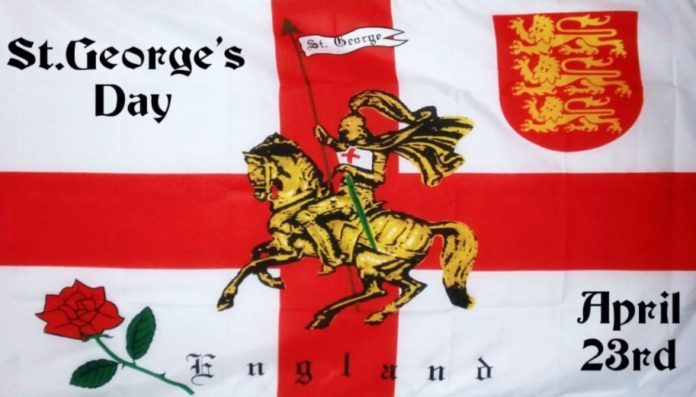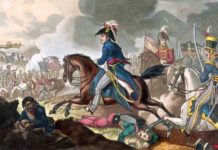St George was not England’s first patron saint, he was adopted by Edward III around 1340 when the king dedicated the chapel he was building at Windsor to the soldier saint who represented the knightly virtues of chivalry he so admired.
Much of the rise in popularity of the legend of St George arose during the Crusades, the medieval religious wars waged by the Christians against their Muslim enemy in the East, from which the legend is believed to originate.
The new taste was for much less passive saints and a more bloodthirsty Christianity, promoted by the clerics who accompanied the soldiers on the Crusades and who recruited huge numbers to the cause.
So it must have been some comfort to know, before setting off into the unknown, that there were mighty Christian warriors, one called George, already there, fighting on your side.
The George and Dragon legend continued to grow in popularity in the Middle Ages thanks to a twelfth-century collection of saints’ lives called The Golden Legend, written by Jacobus de Voragine in around 1260.
The tale it recounts is set near a godless, pagan city called Silene, thought to be in what is now Libya.
In a lake close to this city lived a fearsome dragon which threatened to kill the villagers if they did not provide it with a live animal to eat each day. And so, to appease the monster, they threw it a sheep every evening.
When they had run out of sheep they drew lots as to which children to sacrifice instead. Eventually the king’s own daughter was chosen. He pleaded with his people and promised them all of his gold and half of his land if they would spare her from the dragon, but all they refused.
Standing at the edge of the lake, the trembling princess saw a magnificent young Christian warrior from a nearby town riding towards her, having heard of the king’s plight.
‘I will defend you in the name of Jesus Christ,’ he called as he galloped towards the dragon, which was, by then, approaching his supper.
The dragon turned on George instead but, making the sign of the cross to protect himself, the warrior drove his lance into the neck of the beast with such force the creature was pinned to the ground.
George and the girl then walked the defeated dragon through the town to show the shamed creature to the people. He told them the Lord had sent him to deliver them all from evil and promised to slay the beast if they would become Christians like himself.
The people agreed and the dragon was killed with one mighty blow from the warrior’s sword. On that very spot, fifteen thousand people were then baptized and the king later built a church to the Blessed Virgin Mary on the same site.
Looking at the story more closely, you can see how Christianity had simply appropriated the ancient Greek tale of Perseus and Andromeda.
The legend of St George held firm in England, but likewise, thanks to medieval myth and fable, the story developed and altered over the ages to suit changing tastes and needs.
St George could be co-opted for all sorts of purposes, including folk remedies – as exemplified by a fifteenth-century manuscript advising people how to protect their horses from witches.
At the time it was commonly believed that if a horse was found to be sweating, or tired, in the morning, then a witch or hag had stolen it during the night and ridden the animal hard.
To prevent this, according to the manuscript, you should hang a flint with a small hole in the middle above the stable door to remind the witch, if she appeared in the night, that St George had banished her for all time. And apparently that worked.
The story of St George remained extremely popular, leading to later embellishment by Richard Johnson in his ‘Famous History of the Seven Champions of Christendom’ (1596).
Johnson removed most of the Christian religious references and replaced them with chivalrous and noble ideals, reflecting the romantic era of the knights and the Crusades.
According to this version, George is a lad born in Coventry to aristocratic parents but is stolen soon after birth and taken east. As he grows up he bravely saves the King of Egypt’s daughter, Princess Sabra, from a fearsome dragon and as a reward is told of his true ancestry.
With that he returns to Coventry (rather than being sent there) where, before long, he is unlucky enough to encounter another dragon on Dunsmore Heath in Warwickshire.
Although George manages to save the people by slaying this second dragon, he is himself poisoned by the beast’s evil breath during the battle and dies soon afterwards, in the process securing a place in English folklore for ever more.
His body, Johnson writes, is buried in the Chapel at Windsor that Edward III had dedicated to him.
And so the legend of the exploits of St George – possibly a form of early propaganda intended to bolster Crusader morale, later adopted by Edward III as he revised his military machine, making George the patron saint of England in the process – became part of English folklore, accounting for why you may have a pub or hotel near you bearing that name.
Interestingly, the St George’s cross that forms the flag of England was originally the flag of Genoa, adopted by the City of London in 1190 so that English ships would be protected by the Genoese fleet when they entered the Mediterranean.
It was then taken up by the English soldiers during the later Crusades as the insignia for their uniform – hence its association with St George as a crusading knight.
St George remains the epitome of English patriotism. The king’s rallying cry at the Battle of Agincourt in Shakespeare’s Henry V – ‘God for Harry, England and St George!’ (Act 3, Scene 1) – offers up a memorable trilogy for victory, especially during time of actual war (Laurence Olivier’s famous celluloid portrayal of Henry V helping to boost flagging British spirits in 1944).
St George’s Day in England falls every year on 23 April, which is incidentally also the day Shakespeare was both born and on which he died. – Albert Jack
Albert Jack AUDIOBOOKS available for download here

More Urban Legends with Albert Jack






































